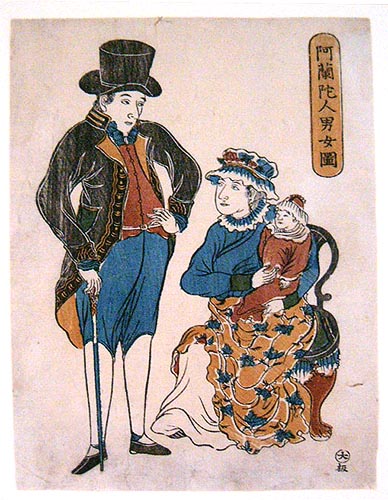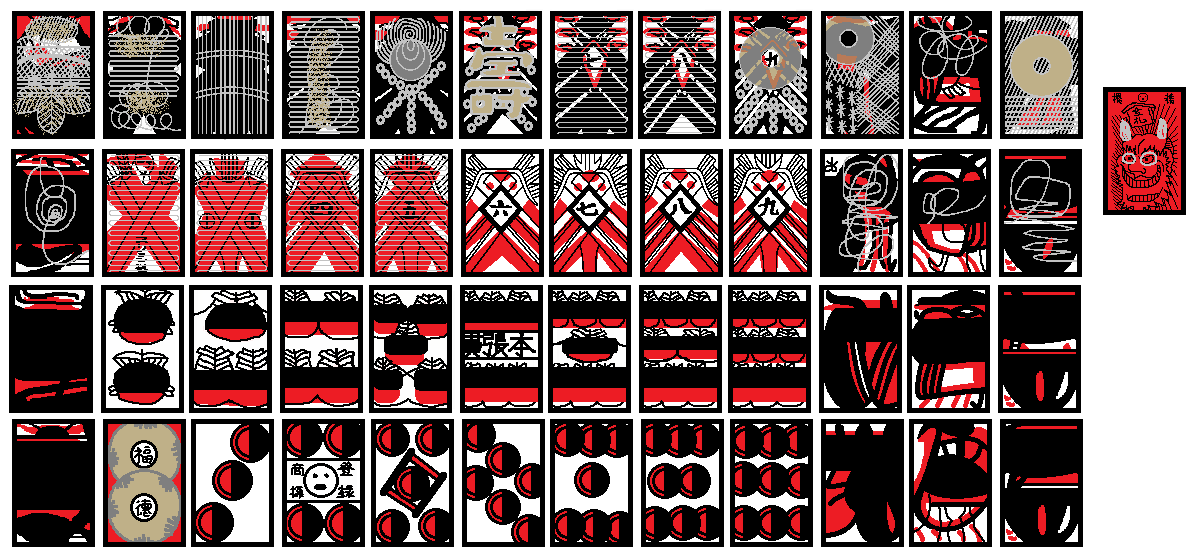Blomhoff’s Mekuri is an account of the rules of the game Mekuri as written by Jan Cock Blomhoff, the director of a Dutch trading colony in Nagasaki called Dejima, in a catalog of his collection of Japanese relics obtained in 1824.

The game can be played by 2 or 3 people.
¶ The Cards
48 cards from a Mekurifuda deck are used. The Onifuda card may or may not be included.

¶ Names of Suits
| SUIT | Name |
|---|---|
| Clubs | Aka |
| Swords | Ao |
| Cups | Kappa |
| Coins | Taiko |
¶ Names of Numbers/Courts
| NUMBER | Name | NUMBER | Name |
|---|---|---|---|
| 1 (Dragon) |
Mushi | 7 | Shichi |
| 2 | Ni | 8 | Hachi |
| 3 | San | 9 | Ku |
| 4 | Shi | 10 (Maid) |
Juu |
| 5 | Go | 11 (Horse) |
Uma |
| 6 | Roku | 12 (King) |
Kiri |
¶ Game Setup
¶ Choosing the Dealer
There is no attested method for choosing a dealer, so you may use whichever method suits you.
¶ Dealing the Initial Cards
-
For 2 players - 10 cards are dealt to each player, and 8 cards face-up to the table. The remainder of the deck is placed face-down to form the draw pile.
-
For 3 players - 7 cards are dealt to each player, and 6 cards face-up to the table. The remainder of the deck is placed face-down to form the draw pile.
What happens if 4 cards of the same number are dealt to the table has not been attested - usually a misdeal is declared (since these 4 cards are impossible to capture); In this case, the cards are thrown in, shuffled again, and re-dealt. Other rules should probably be agreed upon as a house rule.
Whether or not 4 cards of the same month in a player’s hand constitutes as a misdeal has not been attested - the specific answer to this question should probably be agreed upon as a house rule.
¶ Gameplay
The core gameplay is identical to Hana-awase, except that instead of matching flowers, numbers/courts are being matched instead.
The game ends when all players run out of cards in hand.
¶ Onifuda (Optional)
The account states that the Onifuda (‘Demon card’) “beats all other cards”. It is not known if it means that it can capture any card on the field (like a wild card can), or some other gameplay mechanic is used.
¶ Scoring
It is not attested in this account how the scoring is calculated. You may refer to the values indicated on the Card Points and decide how to handle the scoring.
However, prior to this account, on August 15, 1815 in Dordrecht, Blomhoff responded to a letter sent to him by R. P. Cruden who was inquiring about Japanese Karuta. In the response, he describes a method of playing the game which closely matches that of Mekuri. He mentions that “The winner of the game is the first to reach a pre-determined score of 100 or more, but I should point out that I do not know how this scoring is done.” This suggests that the scoring in the game is cumulative, rather than zero-sum.
¶ Card Points
Clubs, Swords, and Coins are considered Scoring Suits.
Cups is considered the Junk Suit, which “doesn’t give any points”; however, the points mentioned below contradict this statement.
- Dragon, Maid, Horse, and King of Junks are worth 1 point each. All other junks are worth 0 points each.
- 2 to 9 of Swords are worth 1 point each.
- 2 of Clubs, and all Horses and Kings of Scoring Suits are worth 3 points each.
- 5 of Clubs, 2 of Coins, and all Maids and Dragons of Scoring Suits are worth 5 points each.
- 7 to 9 of Clubs are worth 2 points each.
- 4 of Clubs is worth 4 points.
- 6 of Clubs is worth 6 points.
¶ Card Points Table
| NUMBER | Clubs | Swords | Coins | Cups |
|---|---|---|---|---|
| 1 (Dragon) |
5 | 5 | 5 | 1 |
| 2 | 3 | 1 | 5 | 0 |
| 3 | 0 | 1 | 0 | 0 |
| 4 | 4 | 1 | 0 | 0 |
| 5 | 5 | 1 | 0 | 0 |
| 6 | 6 | 1 | 0 | 0 |
| 7 | 2 | 1 | 0 | 0 |
| 8 | 2 | 1 | 0 | 0 |
| 9 | 2 | 1 | 0 | 0 |
| 10 (Maid) |
5 | 5 | 5 | 1 |
| 11 (Horse) |
3 | 3 | 3 | 1 |
| 12 (King) |
3 | 3 | 3 | 1 |
¶ Yaku
In addition to the usual card point scoring, each player who forms a yaku receives additional points from each of the other players.
A Yaku’s value is measured in units of a pre-determined amount, which should be agreed upon before starting the game, and may be in points or in cash.
The account mentions that the Yaku consisting of the Dragon, 2, and 3 of either Clubs or Swords are considered the highest scoring of all the Yaku. The list of Yaku also mentions their values, which contradicts the above statement.
¶ List of Yaku
| Value | Card 1 | Card 2 | Card 3 |
|---|---|---|---|
| 2x the amount | Club Dragon | Club 2 | Club 3 |
| 2x the amount | Sword Dragon | Sword 2 | Sword 3 |
| 2x the amount | Club 4 | Club 5 | Club 6 |
| 2x the amount | Sword 4 | Sword 5 | Sword 6 |
| 2x the amount | Club 7 | Club 8 | Club 9 |
| 2x the amount | Sword 7 | Sword 8 | Sword 9 |
| 3x the amount | Club Maid | Club Horse | Club King |
| 3x the amount | Sword Maid | Sword Horse | Sword King |